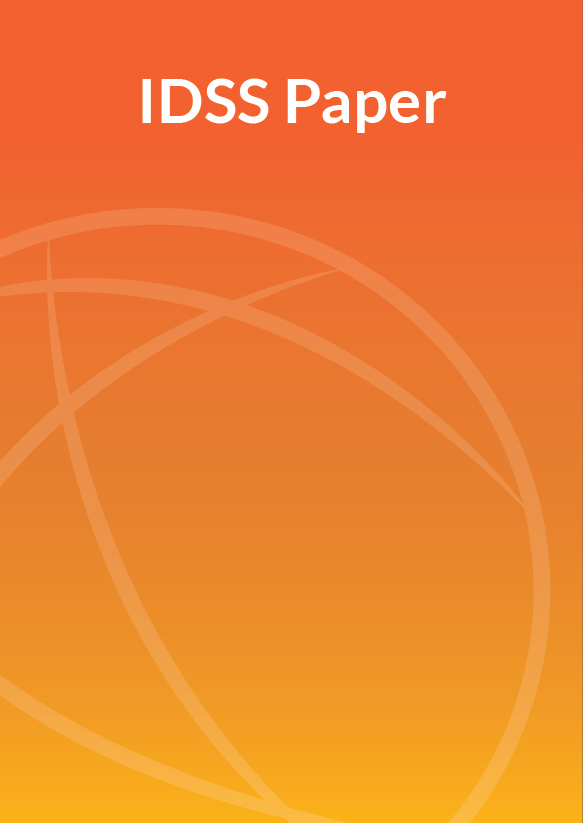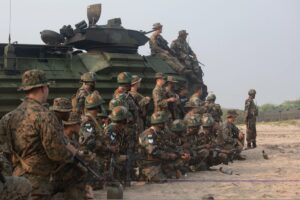Publications

SYNOPSIS
COMMENTARY
Natural hazards pose significant threats to the Indo-Pacific. In 2021, the region accounted for nearly half of disaster-induced fatalities and 23% of economic losses in the world. Climate change adds to the risks facing the region as climate extremes are projected to increase in frequency and severity. The ongoing COVID-19 pandemic has further strained personnel, resources and logistics in disaster responses. These trends highlight the need to strengthen regional militaries’ capacity for collective response in the area of humanitarian assistance and disaster relief (HADR). Military involvement in disaster response is common in this region and foreign military assistance is requested when national military assets are inadequate.
Success and Constraints of the ASEAN Model
The ASEAN countries have built a multi-layered network to support collective response to disasters in the region. Established institutions and platforms contribute to better communication and coordination on HADR issues. Relying on its convenient location in the region and network of international liaison officers, the Changi Regional HADR Coordination Centre (RHCC) hosted by Singapore was launched in 2014 to enhance regional coordination in HADR. The RHCC shares information to facilitate informed deployment-related decision-making on the part of partner militaries and avoid duplication when a disaster strikes across the wider region. Platforms such as the ASEAN Regional Forum and the ASEAN Defence Ministers’ Meeting (ADMM)–Plus have facilitated multi-level engagement on HADR issues between ASEAN and its dialogue partners since the 1990s through regular meetings and workshops as well as joint training and exercises. These activities help connect focal points of contact from different countries and sectors, including military forces, government agencies, regional and international organisations, and humanitarian agencies, to foster a regional network of disaster relief.
However, it is necessary to recognise the difficulty for ASEAN to go beyond a facilitative role. Currently, collective response takes the form of multiple bilateral responses, as seen during the Palu earthquake and tsunami in Indonesia in 2018. Eighteen countries deployed assets through direct coordination with the Indonesian military forces, while the RHCC Centre was not utilised. The same pattern was seen in military responses to COVID-19 in the region, with one military delivering critical medical supplies and vaccines to another bilaterally. It shows the ASEAN countries’ preference for dealing with military HADR interactions primarily by themselves with some engagement through regional mechanisms, an approach that ultimately limits the depth of HADR cooperation in the region. A more regionalised response to HADR under the ASEAN banner can contribute further to enhancing the speed and efficiency of coordination and deployment. The discussions for the establishment of an ASEAN Militaries Ready Group on HADR since 2015 can be seen as a step in this direction.
Quad and LMC as Alternatives: Potential and Uncertainty
Although the Quadrilateral Security Dialogue (Quad) and the Lancang Mekong Cooperation (LMC) are relatively new and under-institutionalised mechanisms, compared with ASEAN, the two arrangements have the potential both in resources and capabilities to be more operational. The Quad, consisting of Australia, India, Japan and the United States, evolved from the core group of relief nations after the Indian Ocean tsunami in 2004 and was revived by the participating countries in 2017. Motivated by the need to contain the growing influence of China, the revived Quad is now primarily a cooperative mechanism for traditional security concerns. However, all four countries are key HADR providers in the Indo-Pacific and have mature bilateral or trilateral military partnerships, which reduce common concerns in HADR operations, such as interoperability, communication and logistics at the country-to-country level.
Interoperability between the United States and Australia as well as Japan is high due to their long-standing security alliances. Australia and Japan signed the Reciprocal Access Agreement in January 2022, which deepens bilateral security cooperation, including in HADR. Interoperability between the Indian military and the other three is increasing as Australia and Japan have been invited to join India’s Malabar naval exercise, which started in 1992 on a bilateral basis between India and the United States. As Australia, India and Japan are located in different subregions of the Indo-Pacific, and the United States has an extensive military presence across the region, logistics for collective responses under the Quad framework is not likely to face major constraints.

However, the place of HADR on the Quad agenda is unclear. The Quad Leaders’ Joint Statement adopted in March 2021 pledged to respond to an array of global challenges, including HADR. However, it disappeared in the joint statement of September 2021. Following the unfolding crisis in Ukraine, the four leaders indicated an interest in establishing a regional mechanism for HADR. These changes possibly suggest that areas in direct competition with Beijing are viewed with higher urgency and importance, such as COVID-19 and emerging technologies. The wavering attitude to HADR raises uncertainty over the Quad’s sustained commitment and investment in collective response. In addition, despite the common goal, the calculations of the four countries on HADR deployment do not necessarily always converge as some may still prefer bilateral assistance over collective response under the Quad banner on some occasions. It remains to be seen how the HADR mechanism within the Quad will balance the diverging interests and concerns of the four participating countries.
The LMC, which involves Cambodia, China, Laos, Myanmar, Thailand and Vietnam, was launched in 2016 in Sanya, China. Disaster response is not among its founding five priorities of connectivity, production capacity, cross-border economic cooperation, water resources, and agriculture and poverty reduction; however, it has appeared in recent declarations. The LMC is not designed as an HADR provider, evident in the fact that it did not provide emergency relief to the LMC counties hit by deadly floods in November 2020. Instead, China provided bilateral aid to the affected countries through its embassies. The declaration following the third LMC leaders’ meeting in August 2020 specified the emergencies for which humanitarian assistance will be provided, which include floods, droughts and landslides. As such, it can be assumed that HADR within the LMC context is broadly linked to water management. The declaration also pledged to strengthen “collective response” to future public health emergencies.
The motivations for the LMC fundamentally differ from the two aforementioned platforms, yet HADR now makes it into the LMC’s declarations. First, the LMC is primarily intended to enhance socio-economic cooperation, even though political and security cooperation is one of the three pillars. Geographically, its focus is on the Mekong subregion. Second, China is obviously the most resourceful and capable provider due to its size and clout as an external partner for HADR efforts. The LMC region has been a priority area in China’s active diplomacy during the COVID-19 pandemic, with a special fund for public health established in 2020 to support infectious disease control in the subregion. In the past two years, Beijing has deployed military medical teams and donated vaccines to its LMC counterparts through the Chinese Defence Ministry. These bilateral activities have been listed as examples of cooperation under LMC. They significantly outnumber the bilateral interactions between other LMC countries tracked by the LMC secretariat. The power imbalance between the LMC countries can be a double-edged sword for possible collective action under the LMC banner, and differentiating LMC responses from China’s own diplomatic offensive is crucial.
Conclusion
The proliferation of multilateral mechanisms can potentially benefit HADR by broadening the sources of personnel, capabilities and resources. However, ASEAN’s experience shows the difficulty in moving towards meaningful collective response in HADR in multilateral contexts. As the Quad and LMC were not revived/established for humanitarian purposes and do not have clearly defined arrangements for collective responses, their collective action in HADR, other than in the form of joint exercises, are likely to be ad hoc at best.
